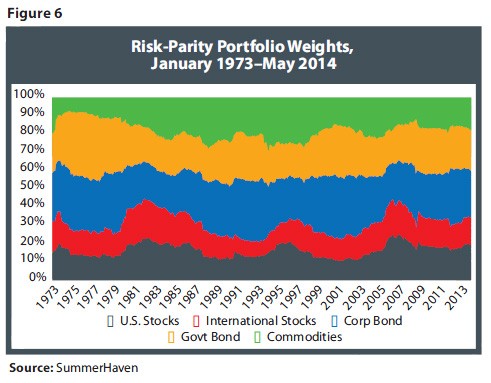Why Commodities Belong In Your Portfolio
Post on: 18 Апрель, 2015 No Comment

Investors looking for the optimal way to play the markets have found that a diversified portfolio is truly the best way to allocate assets. Diversification spreads risks while granting exposure to various corners of the market that behave quite differently depending on the current environment. For quite some time, the biggest debate has not been whether investors should diversify, but how to do it. Many fight over allocations to two asset classes; equity and fixed income, as these two are the traditional mainstays of any portfolio. While finding the right balance between the two can have a major impact on your portfolio, there is one asset class that many investors overlook; commodities.
It used to be that commodity exposure was left primarily for active traders, as complex and risky futures contracts were the primary way to allocate to these investment options. Now, with the help of the rapidly expanding ETF industry, investors can establish a long term exposure to commodities without having to play the futures markets by trading on margin. There are exchange traded products that execute a roll process on a monthly basis to maintain constant futures exposure and there are also ETFs that offer physical exposure to a particular commodity like gold. These options have only just emerged in the past few years, leading many investors to be skeptical of commodity exposure as a part of a long-term portfolio, but these investments offer a wealth of opportunities for traders [see also Analyzing Five High Yielding Oil & Gas Pipeline Stocks ].
Commodity Benefits
Commodities help investors hedge against the nasty effects of inflation, as the prices of these resources tend to rise parallel to inflation. Broad-based natural resource exposure can provide access to an asset class that should perform well in such environments. Now that the Fed has announced that it plans to hold its rates at virtually zero through mid-2013, inflation fears are higher than ever, as any kind of uptick of an inflationary environment cannot be battled with interest rates for nearly two years. Commodity exposure will allow investors to account for inflation in both the long and short run in their portfolio which is especially important given the current outlook for the U.S. economy. Also consider that the supply of commodities is limited in a sense; while farmers can grow less or more of a certain crop, commodities themselves are not subject to the inflation that currencies and equities experience when it comes to adding money to the system like one of the quantitative easing programs [see also Ultimate Guide To Copper Investing ].
Another major benefit offered by investments in these resources comes from their low correlation to stocks. While there are numerous companies, like miners, who find themselves somewhat anchored by commodity prices, the commodities themselves have little to no relation to equity markets. This means that on a day that all of your major equity holdings are down, it is very possible that your commodity exposure could be paring losses with steady gains. The idea of a well-diversified portfolio is to have low correlation in order to spread risks, and with some commodities exhibiting almost zero correlation to stocks, there is no question that they have a place in your portfolio [see also Precious Metals ETFs. Finding The Best Fit ].
Still not convinced? Consider then the emerging markets of the world. The majority of commodities are consumer goods that are being gobbled up by emerging markets that are experiencing exponential population growth, and as the years go on, demand for these goods will likely only increase. The world population is currently sitting just under seven billion, but by 2050, that figure is expected to increase to an astonishing 9.2 billion, meaning that there will be a lot more mouths to feed and much higher demand for these commodities. This presents many of these investments as a possible growth opportunity to make a play on population growth and the inevitable surge in global demand.
How To Use Them In Your Portfolio
While commodities are an important cornerstone of any respectable portfolio, they do not deserve a major allocation. Commodities can be dangerous investments as they are typically subject to high volatility and can be incredibly unpredictable. For all of the benefits they provide, commodities can also be a major thorn in an investors side, leading many to consider them as a necessary evil as their day to day returns can stray by hundreds of basis points, disqualifying them from a major portfolio allocation.

Instead, they should be used as something a compliment investment and account for anywhere between 5% and 10% of your portfolio depending on your particular strategy. As for which commodities to pick, there is a laundry list to choose from, including crude oil, natural gas. gold. and more obscure options like orange juice, canola oil, and even butter futures. Investors can trade futures contracts if they can stomach actively moving positions, but the best option for a buy-and-hold investor is to purchase a broad-based ETF that features either physical exposure or an automated roll process [see also Commodity ETFs. Five Factors To Consider ].
When it comes to broad based exchange traded funds there are numerous options that deserve close inspection like DJP. GCC, DBC. and DBA, all of which employ a futures-based strategy. For those looking for physical exposure, products like GLD. SLV, and GLTR may work better for their investment style. Despite how you decide to add commodity exposure to your portfolio, one thing is certain; it is a vital component of any self-respecting diversified basket of holdings and should be embraced by buy-and-hold investors and traders alike.
[For more news on resources, sign up for our free CommodityHQ newsletter .]
Disclosure: Photo courtesy of Robert Knapp. No positions at time of writing.
Commodity HQ is not an investment advisor, and any content published by Commodity HQ does not constitute individual investment advice. The opinions offered herein are not personalized recommendations to buy, sell or hold securities or investment assets. Read the full disclaimer here .














